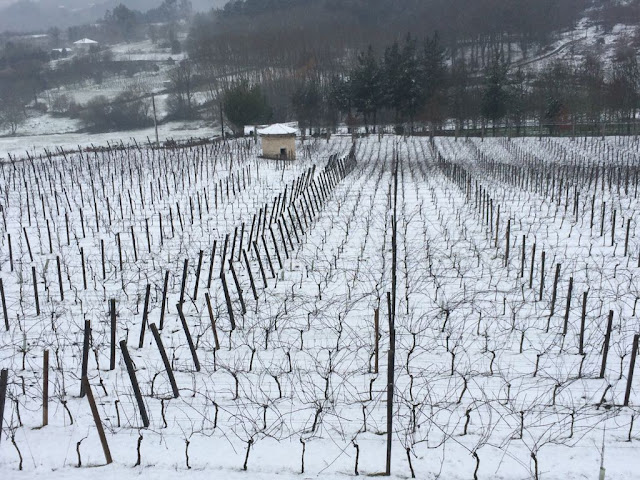A Pita Cega, expresión liquida de la tierra.
Nuestros viñedos están situados a 500 m de altitud, y a 300 m del río Miño cerca de un poblado celta, Lansbricae, que data del Siglo II AC, hasta su romanización. Al parecer, ya entonces, se enviaba vino a Roma, nos cuentan los restos de ánforas encontrados.
Nos rodea un circo de montañas que abrigan nuestras viñas en invierno, el clima es oceánico-mediterráneo, con temperaturas medias anuales de 14ºC y precipitaciones que superan los 1.000 mm anuales, con veranos cálidos, habitualmente secos.
Nuestro suelo, se compone de formaciones poco evolucionadas y asentadas sobre rocas madre de gran dureza, constituidas básicamente por antiquísimos materiales graníticos procedentes del periodo hercínico y grandes cantidades de cuarzo.
Nos rodea un circo de montañas que abrigan nuestras viñas en invierno, el clima es oceánico-mediterráneo, con temperaturas medias anuales de 14ºC y precipitaciones que superan los 1.000 mm anuales, con veranos cálidos, habitualmente secos.
Nuestro suelo, se compone de formaciones poco evolucionadas y asentadas sobre rocas madre de gran dureza, constituidas básicamente por antiquísimos materiales graníticos procedentes del periodo hercínico y grandes cantidades de cuarzo.
Estamos hablando de una peculiar "viticultura del granito", asentada sobre suelo ácido, suelto y bien oxigenado, que dan lugar a un vino fresco, con aroma a azahar, acacia, flores de vid, ciruela Claudia y albaricoque con recuerdos cítricos y plantas aromáticas, amplio, elegante, peculiar y complejo.
En esta finca se sabe de su cultivo, por documentos, que nos llevan al siglo XVI época de la que data la casa y construcciones cercanas.
Cultivamos de forma orgánica, biodinámica, para lograr el equilibrio de este organismo vivo, tratamos las cepas con infusiones de hierbas, del propio terreno y de forma homeopática, nuestros suelos son pobres pero muy vivos, el rendimiento es escaso. En la búsqueda de la biodiversidad, el viñedo, está rodeado de lavandas, mentas, romero, ciruelos, melocotoneros y rosas, que la fauna auxiliar agradece.
La huella de carbono es casi inapreciable. Trabajamos como lo hacían nuestros abuelos, con el alma, en la creencia de que el buen vino, está en la viña, nuestra tierra nos reconcilia con el mundo.
En bodega somos meros observadores de un proceso natural, dejando que la naturaleza se exprese, no necesitamos reparar errores del trabajo en la viña, los procesos de vida presentes en cada una de nuestras uvas, permiten a al zumo, volverse vino por sí solo, nosotros, solo exaltamos la calidad de la vendimia.
Elaboramos el vino desde el viñedo y actuando con sutileza, entregamos al vino, la personalidad de la tierra que lo alberga.
Our
vineyards lie at a height of 500 m (1,300 feet) above the River Miño near the 2nd
century BC Celtic settlement and later Roman fort of Lansbricae. The remains of
amphoras found in the area suggest that wine was exported to Rome even then.
The estate is
ringed by mountains, which protect the vines in wintertime and ensure an
Atlantic-Mediterranean climate with average annual temperatures of 14ºC and
rainfall of more than 1,000 mm per year. Summers are hot and usually dry.
 |
| snow in the vineyard |
The soil is
made up of largely recent formations above a bed of very hard mother rock,
basically consisting of very ancient granites from the Hercynian period and
large amounts of quartz.
This
produces an unusual “granite” viticulture based on acidic, loose,
well-oxygenated soil that produces a fresh wine with a bouquet made up of
orange blossom, acacia, vines, Claudia plums and apricot with citrus and other
aromatic notes. The wine is full-bodied, elegant, singular and complex.
Documentary
evidence shows that wine growing on the estate dates back to the 16th
century when the house and outbuildings were erected.
The vines
are grown organically using biodynamic techniques to ensure a living balance,
and we treat them homeopathically with infusions of local herbs. Our soils are
poor but very much alive, though yields are low. In pursuit of biodiversity, the vineyard is
surrounded by lavender, mint, rosemary, plum trees, peach trees and roses, much
to the delight of insects, birds and small mammals.
Our carbon
footprint is tiny. We work from the soul as our grandfathers did in the belief
that good wine is in the grape. The land reconciles us with the world.
The grapes
are harvested by hand to ensure the selection only of perfectly ripe fruit on
the vine, and only in the early morning to preserve their freshness until they
reach the winery.
At the
winery we are mere observers of a natural process in which Nature expresses
herself, and we have no need to remedy mistakes made in our work in the
vineyard. The processes of life are present in every one of our grapes, and the
must becomes wine of its own accord. We only work to ensure the quality of the
harvest.
Our wine
making begins in the vineyard, and in a subtle process our wine takes on the
personality of the land.
Tasting
notes
Appearance: Bright yellow with lemon reflections.
Appearance: Bright yellow with lemon reflections.
In glass: Rich floral smells of orange blossom and acacia. Yellow Claudia plums, expansive apricot, singular and complex, elegant with slight citrus notes and a hint of herbal infusion at the finish.
In mouth: Fresh acidity with good structure, light and smooth, with a green finish reminiscent of vine tendrils, and a medium to long finish.

Lagar de Sabariz SL
San Amaro. Orense. España
mail : lagardesabariz@lagardesabariz.com
Teléfono: 619 494 720



